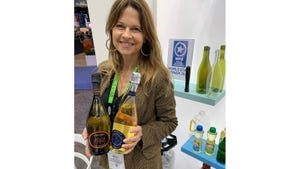Sustainability in Agriculture: Carbon Composite Innovation Halves Chassis Weight of Forage Harvester
A German research project is addressing issues such as high fuel consumption and road usage regulations as agricultural machinery gets bulkier.
September 22, 2023

To reduce CO2 emissions in the commercial vehicle and agricultural sector, new ways are being sought to reduce the weight of vehicles, most of which weigh several tons. One approach is lightweight structural design using innovative material concepts, such as fiber composites.
The Institute for Manufacturing Technology and Machine Tools (IFW) at Leibniz Universität Hannover in Germany, together with its project partners, has developed a carbon composite chassis for the Krone Big X forage harvester as part of the AgriLight project. With the innovative design, the chassis weight of the forage harvester can be reduced by 50% while simultaneously increasing the torsional stiffness of the frame.
In order to be able to work larger fields more efficiently, the performance of agricultural harvesting machines has risen sharply in recent decades. The higher performance of the machines has also increased their weight, which brings manufacturers to the limits of what is permissible under road traffic laws and confronts users with greater soil compaction issues and higher fuel consumption.
This issue was investigated by the AgriLight research project by IFW and project partners Krone GmbH & Co. KG, M&D Composites Technology GmbH, and the Institute for Polymer Materials and Plastics Technology (PuK) of the Clausthal University of Technology. By fundamentally re-engineering the chassis of the Krone Big X into an innovative fiber-composite design, its weight was significantly reduced.
Material challenges
Particular challenges arose from the different material properties of fiber composites and metallic materials, the associated complexity in the design of thick-walled carbon-fiber-reinforced plastic (CFRP) composite structures, and the integration of the new, fiber-compatible design into the existing vehicle structure. The new design possibilities of CFRP monocoque construction were used to create additional benefits for the customer, including larger, integrated tanks and simplified cleaning of the machine thanks to sealed surfaces.
IFW and PuK jointly investigated different resin systems for potential designs to find the optimal matrix for the application and the manufacturing process using vacuum infusion without autoclaves. Ansys Composite PrePost was used to perform the finite element simulation. Shell models of the entire CFRP structure were created as well as detailed analyses using solid models. Based on a load spectrum newly developed by Krone, design adjustments as well as optimizations in the laminate structure were made.
Innovative hybrid insert concept
In addition to the design and dimensioning of the frame structure, the IFW has also researched new approaches for the fiber-composite-compatible introduction of high loads into the frame structure of commercial vehicles. With the aid of the innovative hybrid insert concept, which is optimally suited to the vacuum infusion process, significantly higher loads can be introduced into the fiber-composite structures — together with classic fasteners such as screws and bolts — without the pre-stressing forces having to be borne by the laminate.
In the next step, a prototype of the chassis was produced at M&D Composites Technology. To this end, tooling was first fabricated, followed by production of the individual shell components of the monocoque. This prototype is then subjected to dynamic structural testing at partner Krone, where the developed load spectrum is run on the X-Poster. This validates the design results and the underlying finite element models.
The main objective of this test is to ensure that both the carbon-fiber-based chassis and the hybrid inserts used in highly stressed areas do not suffer any damage over the entire lifetime of a vehicle. IFW is implementing a measurement concept that includes Rayleigh and strain gauge sensors as well as optical 3D measurements to record the loads and deformations of the chassis. Through the development process, IFW has been able to leverage its expertise in the development and design of large fiber-composite structures as well as in the conception of application-related force application.
The AgriLight project is funded by the German Federal Ministry of Economics and Climate Protection (BMWK) as part of the Lightweight Construction Technology Transfer Program (TTP LB).
About the Author(s)
You May Also Like




